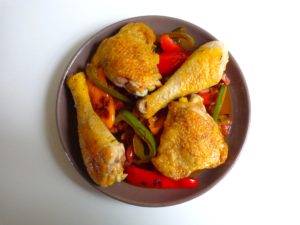
Basque chicken with peppers and tomatoes
This traditional recipe from the Basque country of southwest France combines pan-grilled chicken with a vegetable dish known as piperade, derived from the regional word for pepper. A classic piperade is based on sweet peppers, tomatoes, onions, garlic and the region’s mild dried red pepper, piment d’Espelette.
Give yourself at least an hour to make the dish, as there is a considerable amount of preparation involved before you actually start to cook. The recipe below includes cured ham, a specialty of Bayonne and appreciated throughout the region. If Bayonne ham is not available, substitute Serrano or Parma. The ham may also be omitted — and, if you are vegetarian or vegan, so can the chicken! You will still have a lovely dish with a peasant, and pleasant, flavor.
 A word about the peppers: In the Basque country, they tend to use varieties that are smaller and more tapered than standard bell peppers. I was able to find such peppers at my local market in Paris, in a lovely combination of red, orange and yellow. If these are not available, use bell peppers in a variety of colors.
A word about the peppers: In the Basque country, they tend to use varieties that are smaller and more tapered than standard bell peppers. I was able to find such peppers at my local market in Paris, in a lovely combination of red, orange and yellow. If these are not available, use bell peppers in a variety of colors.
Although this is not traditionally a spicy dish, you can always add some heat with a pinch of cayenne.
1 whole chicken or 4 chicken legs
3 large bell peppers or 8-10 smaller sweet peppers of different colors
1 large onion
3-4 cloves garlic
1 pound (500 grams) ripe tomatoes
1/4 pound (110 grams) very thick-cut cured ham (optional)
3 tbsp. olive oil
salt and freshly ground black pepper
1/2 cup water
1/4 tsp. piment d’Espelette or cayenne (optional)
1 branch fresh thyme or 1/2 tsp. dried thyme
If using a whole chicken, have the butcher cut it into 8-10 pieces. If using legs, separate them into thighs and drumsticks. To find the joint, place the legs skin-side down and locate the separation with your finger. Slice right through with a sharp knife. Set aside.
Remove the cores of the peppers, slice in half, and remove the remaining seeds and as much of the light-colored membranes as possible. Slice into strips. Set aside.
Peel the onion, cut into quarters and slice finely. Peel the garlic and cut into quarters lengthwise. Set aside.
Place a large pot of water on the stove and bring to a boil. Add the tomatoes and boil for 30 seconds. Drain into a colander. When the tomatoes are cool enough for handling, slip off their skins. Cut into quarters and remove the seeds. Chop roughly. Set aside.
Remove as much fat as possible from the ham. Slice into thick sticks about 3/4 inch (2 cm) long. Set aside.
Heat 2 tbsp. olive oil over high heat in a large, heavy skillet — nonstick is good. When the oil is sizzling, add the chicken pieces, skin-side down. Continue to cook over high heat until the skin is golden. This takes about 10 minutes. Turn over the pieces and cook another 5 minutes. Season with salt and pepper. Remove the pieces into a bowl. Set aside.
Discard the chicken fat and wipe the skillet clean with a paper towel. Add 1 tbsp. olive oil and reheat. Add the peppers and sauté over medium-high heat, stirring, until they soften and begin to brown. This takes about 10 minutes. The idea is to obtain a slightly caramelized flavor.
Add the onions and cook another 5 minutes, stirring. Add the garlic pieces and the sticks of ham. Stir briefly.
Add the tomatoes and 1/2 cup water and cook, stirring, about 5 more minutes, until the tomatoes begin to soften into a sauce. Season with salt and pepper (not too much salt, as the ham is salty). Add the thyme and, if using piment d’Espelette or cayenne, add it now. Stir. You now have a piperade.
Place the chicken pieces on top of the piperade, skin-side up. Add any chicken juices that have accumulated in the bowl. Cover the skillet partially to allow steam to escape. Cook 20-30 minutes, until the chicken is tender. You can test for doneness by inserting a fork into the chicken. If the juices run clear, it is done. If the juices are pink, continue cooking for a few minutes.
Serve piping hot, with rice and perhaps a green salad alongside. Serves 4.
This dish may be prepared up to a day in advance and reheated. It will only get better.




